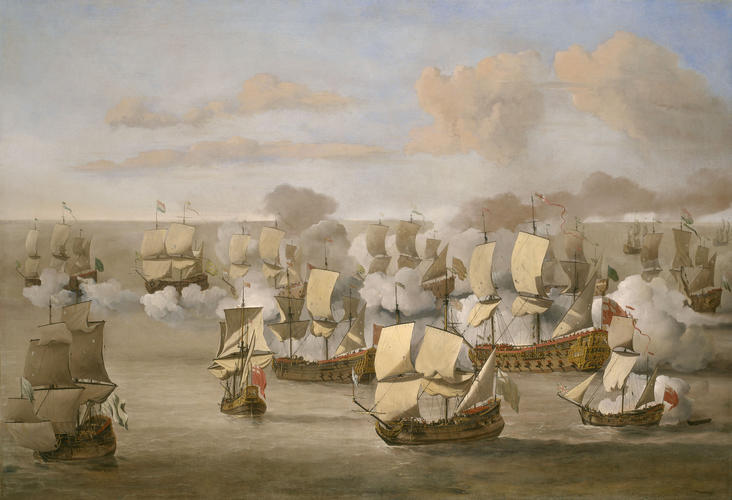-
1 of 253523 objects
The "Mary Rose" Action, 28 December 1669 Signed and dated 1676
Oil on canvas | 126.4 x 182.6 cm (support, canvas/panel/stretcher external) | RCIN 405223

Willem van de Velde the Younger (1633-1707)
The "Mary Rose" Action, 28 December 1669 Signed and dated 1676
-
Upon the Restoration in 1660 Charles II appointed his brother, James (Duke of York and later James II), to the position of Lord High Admiral, in which capacity he commanded the Royal Navy during the Second (1665-7) and Third (1672-4) Anglo-Dutch Wars (the First (1652-4) took place in Cromwell’s time). In 1675 he commissioned from the recently-arrived Dutch artists (Van de Veldes, father and son) a set of large canvases depicting episodes in these two conflicts and the ongoing struggle against the Barbary Corsairs. Previous commissions of this type had been for tapestries, like the famous Armada set hanging at this date in the House of Lords. This is one of several of the paintings in this series which have the character of tapestries, with high view points and a crowding of incidents (as opposed to the sea-level, atmospheric view of their other oil paintings).
The Barbary Corsairs or Pirates operated out of the principal Mediterranean ports of North Africa - Tripoli, Tunis and Algiers - terrorising all shipping in the region and mounting raids against coastal settlement throughout Europe in search of slaves. During their wars against Spain (1568-1648) the Dutch used Barbary bases against Spanish shipping and shared technology with their hosts. Other European sea-powers similarly connived with the pirates when campaigning against each other. Thus encouraged, the menace reached its peak about the mid-point of the seventeenth century. Under Charles II the Royal Navy mounted a systematic campaign against the corsairs, enforcing treaties on each major port in turn. The threat was not however entirely eliminated until 1830.
The Mary Rose was escorting merchant ships from Sallee when on 28 December 1669 and the following day she fought off an attack by seven Barbary pirates and reached Cadiz in safety. The Mary Rose is shown here in the right middle-distance facing six of the enemy (running behind her in a straight line right to left across the middle distance). The merchant ships occupy the foreground, some firing some escaping; reading left to right we see a French merchantman, an English pink, an English frigate just in front of the Mary Rose, a Scottish flute and a ketch. The final Barbary ship chases a merchantman in the right distance.
Inscribed lower right: 'W. V. Velde 167 [ ]' and on the reverse of the relined canvas (presumably copied from the original canvas reverse): 'W. V. Velde 1676.'Provenance
Commissioned by James II when Duke of York
-
Creator(s)
(nationality)Acquirer(s)
-
Medium and techniques
Oil on canvas
Measurements
126.4 x 182.6 cm (support, canvas/panel/stretcher external)
142.8 x 198.5 x 6.1 cm (frame, external)
Other number(s)